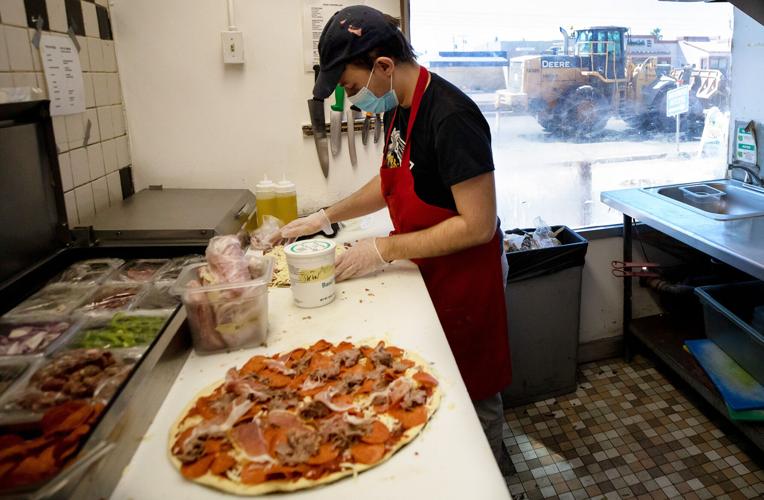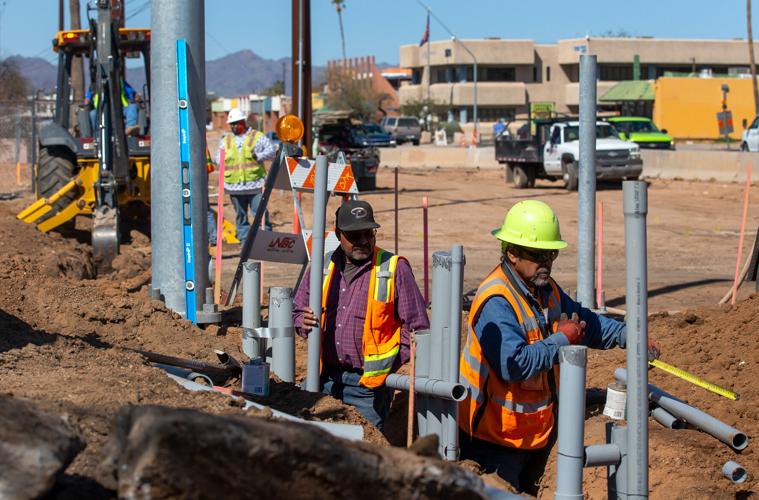Tucson’s road-widening project on East Broadway has been delayed for the third time since it began two years ago, according to officials who said it’s now more than six months behind schedule.
The goal of the project is to widen Broadway from four to six lanes between Euclid Avenue and Country Club Road, as well as install other upgrades like new sidewalks and traffic lights. It was originally scheduled to wrap up last September and the construction has already cost Tucson more than $23 million.
Officials weren’t aware of the most recent delay until they were contacted by the Arizona Daily Star, though they said the constant setbacks are driven by issues ranging from a shortage of asphalt to miles of underground piping that had to be replaced. They have vowed to work with the construction company tasked with completing the roadwork, Ashton Contractors and Engineers, to avoid any more delays.
But business owners along that stretch said they’ve been left in the dark about the delays over the past two years and are still struggling to get customers in the door as the “major” street improvement project drags on.
“I’m just sick of shaking my fist at the sky at this point,” said Rocco DiGrazia, the owner of Rocco’s Little Chicago, a pizza restaurant that’s been caught in the middle of the road work since 2020. “It’s frustrating, I don’t know what to do. What do I do except come to work, open the doors and hope somebody comes in to eat today?”
Rocco’s Little Chicago is situated along the stretch of Broadway between Campbell and Country Club, one of two major pieces of the project that’s not expected to be wrapped up until June. The other section of road work, from Euclid to Campbell Avenue, should now be finished in late April.
Michael Graham, a spokesman for Tucson’s Department of Transportation and Mobility, said the main cause of the three delays has been miles of underground utilities that “changed the scope of the project” significantly.
Construction workers found 20 miles of piping called “home connection sewers” that they didn’t know were there, for example. The pipes connect buildings along the road to Tucson’s main sewer line and are considered “private,” so officials only realized they were buried beneath Broadway after they were dug up.
On top of that, the city had to replace about three miles of storm drain before repaving could begin, the pandemic caused construction staffing shortages and road work was nearly impossible to do during parts of last year’s heavy monsoon season.

Workers place electrical conduits for traffic signals at Treat Avenue and Broadway. The goal of the project is to widen Broadway from four to six lanes between Euclid Avenue and Country Club Road, as well as install other upgrades like new sidewalks and traffic lights.
“Keep in mind that this was a major, major improvement project,” Graham said. “Everything has to fit together like a puzzle — grading, curb (construction), paving — everything is like a puzzle, and if the pieces don’t line up then it affects the schedule down the road. You have to reschedule and balance all of the other activities when one of the pieces doesn’t fit or it’s delayed.”
Graham said the “biggest thing” Tucson has done on the project so far is replacing the three miles of 90-inch-thick storm drain, but some like DiGrazia are frustrated that the city is still “goofing around” with the utility issues two years in.
Councilman Steve Kozachik, whose ward encompasses the area where the project is taking place, echoed the restaurant owner’s concerns, saying the city should have figured out the piping issues sooner than it did.
“My sense is that the civil engineering pieces — the below-grade stuff, the piping, the utilities — should have been determined early on,” he said. “So, I’m not buying that one because from a construction management standpoint that’s stuff that you don’t learn in the top of the eighth inning. You learn that in the second or third inning when you’re doing your due diligence.”
Another major reason for the delays are shortages of asphalt, which Kozachik described as a “legit” reason the project has been pushed back.
Only a limited number of companies make the material in the region, so resources are spread thin. It’s also hard to make enough asphalt ahead of time to meet future needs because it has to be used soon after it’s produced.
“Everybody in the region is essentially relying on the same producers of this and it has to be made, actually produced very close in time to when you’re going to lay it just like concrete,” the Ward 6 councilman said. “You can’t roll the concrete truck up and have it sit there for six hours or this stuff will congeal inside the machinery.”
Regardless of the reasons for the delays, the timing couldn’t be worse for restaurants like Rocco’s Little Chicago that took financial hits during the pandemic that they’re still recovering from. DiGrazia said he doesn’t know how some of the more affected businesses in the area are “even paying their bills,” for instance.
The restaurant owner added that some paving progress in the area has improved things in recent months, but that business is still down for the pizza restaurant because of the never ending construction.
“When there was dirt in front of our place for like a year, it was really bad. I knew anybody who showed up here was making a B-line for my restaurant, there was no incidental traffic at all,” he said. “I think things are getting better, but I still hear from customers and old regulars that they just won’t come because it’s difficult — especially at night, for older folks — to see where the cones are and how the traffic snakes through the new road and stuff like that.”
City officials said they plan to discuss the Broadway project “master plan” with the construction company tasked with completing the work in order to figure out how they can avoid any future delays
Those conversations are expected to take place in the coming weeks and could involve steps such as increasing work hours or doing construction on weekends.
“We’re going to sit down and have a conversation with the contractor to see what we can do to expedite their updated schedule and try to get this done as quickly as possible,” Graham said. “We want people to know that the businesses are open and they’re accessible and to continue to support small businesses along the route because they are open and they are accessible.”






